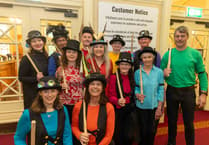Occupying a ’position of singular beauty, well sheltered from north and east winds and commanding magnificent and extensive land, mountain and sea views’ on a promontory between the Silverburn River and Castletown Bay is one of the island’s best houses.
Named after a district of Scotland, Lorne House - originally Lorn - described in contemporary accounts as ’this magnificent building lately erected’, emerged from its predecessor in Castletown by 1828.
The original house was built in around 1786, probably to the design of George Steuart, who had been brought to the island by the Duke of Atholl.
It had three adjoining rectangular blocks forming a square with a porch on the eastern frontage and a semi-circular bay on the south. Steuart designed a similar bay for the Villa Marina, the building on the Douglas seashore - and later on Harris Promenade - demolished in 1912 to make way for the current complex of the same name.
A fourth block was added to Lorne House to enable construction of a magnificent staircase and various extensions. Robert Cunninghame, its owner, was former Attorney General and a House of Keys member who had inherited the property from his father, Lieutenant Colonel William Cunninghame, formerly of the 58th Regiment of Foot, who also owned Ballanorris. William, who died in 1825, had married Christian Taubman in the early 1790s, the Taubman family having previously owned the site. Their son Robert celebrated the building’s new look in February 1828 with an assembly.
We are told: ’Great taste was displayed in the decoration of his elegantly colonnaded hall: the staircase was peculiarly striking, from the singular and beautiful effects produced by the neatly entwined wreaths of evergreens which encircled the light fluted columns of this princely mansion.’
Robert only enjoyed his creation for four years before dying suddenly in 1832, leaving his widow Margaret, nee McDougall, and four children, including an heir, Patrick Taubman Cunninghame, who was still a young child. Both Margaret and Robert’s mother Christian died two years later, and with the heir Patrick, born in 1827, being only seven years old, this meant Lorne House’s role was about to change.
The Governor’s accommodation in Derby House in Castle Rushen had largely been converted into a courthouse, but not far away - sitting dominant above other properties east of the Silverburn (apart from Quayles’ Bridge House, which, following a contretemps, they had heightened to block the Cunninghames’ seaward view) and standing empty from 1834 - was Lorne House. It was decided this would admirably fulfil the need for a suitably elegant and dignified property to become the home of then Lieutenant Governor, John Ready.
A 13-year lease was taken out and was then renewed until 1860 for Lieutenant Governor Charles Hope. Cunninghame’s grandchild, however, having come of age, then declined to renew the lease as he wanted Lorne House for himself, so Hope became ’homeless’. That was the beginning of the end for Castletown as capital of the Isle of Man - Castle Mona in Douglas was intially leased by the Lieutenant Governor instead before Bemahague became the permanent home for successive holders of the post. Tynwald then followed, moving away from the old House of Keys in Castletown to Douglas.
Cunninghame descendants eventually sold out to philanthropist Henry Bloom Noble in 1893, but none of his usual goodwill towards the property is recorded: following his death in 1903 for £100, trustees conveyed ’that mansion house, gardens, grounds, lodge, stables, field and premises, including a parcel of land formerly waste landâ?¦ and now part of Lorn House, and also including Lorn House and whole of lands houses and premises lying between the Victoria Road Douglas Road and the road leading past the Bowling Green Stables to the Victoria Road’ to General Stevenson, who had leased the property for some time.
Stevenson built the archway at the head of the drive in 1902 and planted an avenue of trees to commemorate the end of the Boer War. A ’fosse’ was created on three sides of the house and relocation of the porch allowed light into the basement, and by then - when the house had also acquired the ’e’ on the end of Lorne - its curtilage was clearly defined.
Described in 1892 as extensive pleasure grounds, the sloping lawn at the side of the house was used for croquet and its surroundings were clearly seen as an important asset of the whole property. In 1907 a fancy fair was held with stalls under the trees, including one held by the then Lieutenant Governor’s wife, Lady Raglan, with pierrots in a large tent some distance from the house, and numerous side shows.
But then in 1921 The Homefinder magazine carried the following: ’For sale: Castletown Lorne House with immediate possession. Mansion House called "Lorn House" with paddock, flower and kitchen gardens . . . gardener’s cottage, coach or motor house, stabling, out-offices, green house, vinery’.
In 1931 Lorne House was acquired by Christian Endeavour Holiday Homes. Opening from the week before Whitsun until the middle of September, by 1972 it accommodated 100 people in the house, converted garage and lodge.
During the Second World War it was occupied by the Manx Children’s Home displaced from Glencrutchery Road by the Royal Navy.
The house had all the accoutrements in its make-up and its surrounding buildings and grounds to be as self-sufficient as possible.
By the 1970s, to raise money for its upkeep, planning consent was sought to develop the grounds, but following refusal, the property was sold to Mannin Industries.
Permission was refused for its conversion to a hotel but was given for offices.
By 1994 its walled kitchen garden was being used to nurture a flock of Loaghtan sheep, and the stables, coach house, piggeries, chicken houses, cowshed and [remains of an] icehouse, described in Patricia Tutt’s book on the estate as ’a form of flying freehold’, still existed.
The sandy ridge of Lorne House Hill - by repute an early Tynwald and gallows site - has another name, ’Howyngren’ - ’hill of the sun’ - with the name of the nearby Bowling Green house, of which there is now no sign, being a corruption of ’Boayl yn Ghrian’ - ’place of the sun’. In 1898 antiquarians here saw slight traces of earthworks, possibly of a promontory fort on this prominent site.
There is no definitive evidence of the ’Chapel and Burial ground’ marked on the 1868 OS map to be found. The chapel’s stones had been reused in the construction of the barn and the well once associated with a keeill was under an arch to the rear of the farm buildings. Another in the centre of the rose garden in front of the house was filled in and covered by a sundial.
In short, Lorne House’s grounds, including the field to the north surrounded by a substantial wall enclosing its historic seven and a half acres, have always formed part of its heritage.
Leighton Stowell, describing this field in 1975, stated: ’It would be a thousand pities if this historic site were used for the erection of ugly houses we see growing up around us in a night, and we Castletown folk trust we will always have Gallows Meadow as one green spot at least in the ancient capital of Mann, which means so much to us all.’
In more recent times Lorne House has been converted back to a single residence, but the current owner now wants to develop housing in the curtilage.




.jpg?width=209&height=140&crop=209:145,smart&quality=75)